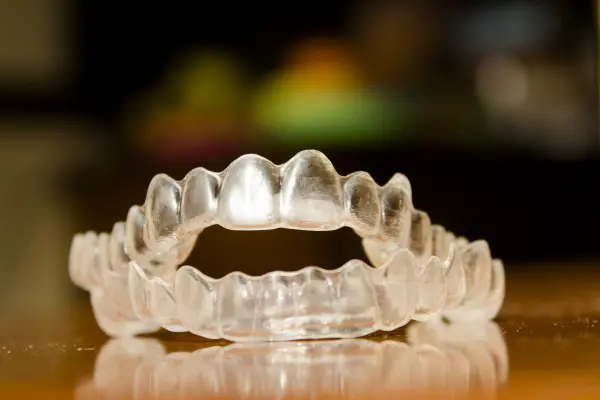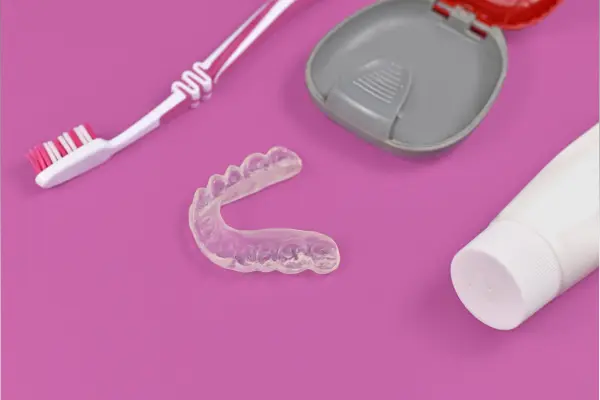Crooked teeth are a common oral health concern that not only affect the orofacial system but also negatively impact a person’s psychological well-being. There are different types of malocclusions due to which people seek orthodontic treatments to make their teeth look straighter and to feel more confident. Having crooked teeth can be a leading cause of oral health issues. People who choose clear aligners as an orthodontic treatment are interested in knowing how they can maintain their oral health while undergoing the treatment. So, let’s go into detail on how you can maintain your oral health while simultaneously fixing your crooked teeth with clear aligner treatment.
What Are Clear Aligners?

Clear aligners are a series of close-fitting custom-made orthodontic appliances that are used for teeth straightening. As a removable alternative to braces, their ‘invisible’ appearance, convenience and flexibility have made them a popular choice for those wishing to straighten their teeth discreetly. Clear aligner treatment demonstrates promising results in terms of controlling plaque index, gingival health, and the prevalence of white spot lesions.
In recent years, a growing number of adult patients have expressed a desire for more comfortable and aesthetically acceptable options to traditional fixed equipment when considering orthodontic treatment. Patients’ needs have been satisfied by the aligners’ transparency and minimal stiffness. Additionally, throughout their orthodontic treatment, patients who used aligners reported less pain and a higher quality of life. However, the most common question is how to take care of oral health with clear aligners. So, without any wait let’s get into it.
Why Is Oral Hygiene Important With Clear Aligners?
It is always important to have great oral hygiene routines in our everyday lives. However, when you are wearing clear aligners, it becomes even more important. This is because you lose the protective effect of saliva washing over the teeth and gums throughout the day. The barrier of aligner plastic keeps the saliva from reaching the teeth to re-harden enamel and fight bacteria. Hence, the significance of oral hygiene becomes crucial and twice as important.
Daily Oral Hygiene Routine During Clear Aligner
Maintaining a good oral hygiene routine is crucial when you’re using clear aligners. Your teeth are shifting into their new positions, and you want to keep everything clean and healthy during this process. Here’s a simple guide to help you get started:
“Using clear aligners along with keeping good oral hygiene, like regularly brushing, flossing, and dental check-ups can speed up the process of achieving that brighter smile which clear aligners are designed for.”
-Dr.Athar
Importance of Brushing and Flossing Regularly
First and foremost, you must understand that brushing and flossing regularly is non-negotiable. You should brush your teeth at least twice a day, and floss once a day. This helps remove food particles and plaque that can build up and lead to cavities, gum disease, and bad breath. When you’re wearing clear aligners, it’s even more important because any food left behind can get trapped under the aligners and cause problems. To keep your mouth smelling fresh and clean with clear aligners it’s best that you follow our tips on maintaining oral hygiene.
How to Brush and Floss with Clear Aligners
Let’s take a look at the best practices for brushing your teeth and flossing with clear aligners/
Brushing with clear aligners
- Remove your clear aligners before brushing your teeth.
- Use a soft-bristled toothbrush and apply a pea-sized amount of fluoride toothpaste.
- Brush all surfaces of your teeth, including the fronts, backs, tops (chewing surfaces), and along the gumline, for at least two minutes.
- Gently brush your tongue to remove bacteria and keep your breath fresh.
- Rinse your aligners with lukewarm water and gently brush them with a soft toothbrush and mild soap before putting them back in.
Flossing with clear aligners
- Floss your teeth at least once a day.
- Use about 18 inches of dental floss, winding it around your fingers, leaving about 1-2 inches to work with.
- Gently slide the floss between your teeth, avoiding snapping it against your gums.
- Move the floss up and down against the sides of each tooth, curving it around the tooth to clean below the gumline.
- If traditional floss is difficult, consider using floss picks or a water flosser for ease.
Tips for Cleaning Your Clear Aligners

To keep your clear aligners clean and germ free, you can use a commercial cleaning solution or make your own by mixing equal parts water and hydrogen peroxide or water and vinegar. You must Soak your aligners for 15-20 minutes, then rinse them thoroughly with cool water. Soaking options include trying to deep clean your aligners.
“Keeping your clear aligners clean is very important. For this purpose, use a separate toothbrush and you can also use antibacterial soap and denture cleaning tablets to prevent bacteria from building up after that rinse it thoroughly with lukewarm water.” -Dr. Athar
- Antibacterial soap and water soak: You can soak your aligners in liquid antibacterial soap and hydrogen peroxide for 15-20 minutes. Then, you can manually scrub the aligners with a soft-bristled toothbrush to remove any remaining bacteria.
- Mouthwash: Mouthwash is another safe and effective way to keep your clear aligners free from bacteria. Mix a small amount of mouthwash with lukewarm water, soak your retainers for 15 minutes, and then rinse thoroughly with plain water.
- Baking soda and water soak: You may use vinegar or baking soda for its deodorizing properties, which are very effective in cleaning plaque and tartar.
- Cleaning tablets: Cleaning denture tablets are specially designed to clean and disinfect aligners effectively.
Whatever the solution may be used, never soak your aligners for more than 30 minutes. Rinse thoroughly with water after each soak. The truth is, your clear aligners don’t need over-use of harsh chemical cleanings. Keep it simple and they’ll stay in good shape and hygienic.
Diet and Oral Health with Clear Aligners
When you’re undergoing clear aligner treatment, your diet plays a significant role in maintaining good oral health and ensuring the success of your treatment. Clear aligners offer the convenience of being removable, but this also means you need to be extra cautious about what you eat and drink. Here’s a detailed guide to help you navigate your diet during your treatment.
Foods to Avoid with Clear Aligners
There are certain foods and drinks you should avoid while wearing clear aligners to prevent damage and maintain oral health. Sticky and chewy foods, like caramel and gummy candies, can stick to your teeth and aligners, making them difficult to clean and increasing the risk of cavities. Hard foods such as nuts, hard candies, and raw carrots can crack or break your aligners if you bite into them too forcefully.
Sugary and acidic foods and drinks, including soda, sports drinks, candy, and citrus fruits, can erode tooth enamel and lead to cavities, especially if they get trapped under your aligners. Additionally, staining foods and drinks like coffee, tea, red wine, and berries can discolor your aligners, making them less invisible and potentially staining your teeth.
Healthy Eating Tips with Clear Aligners
To keep your mouth healthy and your treatment on track, it’s important to follow some dietary recommendations. Staying hydrated is crucial, as drinking water throughout the day helps rinse away food particles and bacteria, keeping your mouth clean. Make water your go-to drink, especially when your aligners are in, as it’s the best way to stay hydrated without risking damage to your aligners.
Eating a balanced diet that includes fruits, vegetables, lean proteins, and dairy products is essential. These foods provide vital nutrients that support oral health, such as calcium for strong teeth and gums. After meals, brushing your teeth ensures that no food particles are left on your teeth, which can cause cavities and bad breath. If you can’t brush immediately, at least rinse your mouth with water before putting your aligners back in.
Final Thoughts
It’s essential to clean your aligners on a regular basis to keep them effective, hygienic, and clear. You may take advantage of the advantages of a straighter smile more quickly and hassle-free with proper cleaning as it will extend their lifespan and improve their performance.
Maintaining good hygiene can also assist to keep teeth and gums healthy by preventing the accumulation of bacteria and plaque. You may effortlessly take care of your aligners and preserve the best-looking smile with simple actions and persistent work.
FAQs
1.How often should I brush and floss while undergoing clear aligner treatment?
You should brush your teeth at least twice a day and floss once a day to maintain good oral hygiene. It’s particularly important to brush and floss before putting your aligners back in after eating to remove food particles and plaque that can get trapped and cause cavities or gum disease.
2. Can I eat or drink while wearing my clear aligners?
You should remove your clear aligners before eating or drinking anything other than water. Eating or drinking with your aligners, can cause food particles and liquids to get trapped between your teeth and the aligners, leading to plaque build-up, cavities, and staining of the aligners.
3. How should I clean my clear aligners to keep them in good condition?
Clean your aligners daily by rinsing them with lukewarm water and brushing them gently with a soft-bristled toothbrush and mild, clear soap. Avoid using toothpaste or hot water, as these can damage the aligners. Once a week, soak them in a retainer cleaning solution or a mixture of white vinegar and water for a deeper clean.
4. What should I do if my clear aligners start to smell or taste bad?
If your aligners develop an unpleasant odor or taste, it may be a sign they need a more thorough cleaning. Ensure you are cleaning them properly every day and consider using a retainer cleaning solution or a mixture of hydrogen peroxide and water occasionally. If the problem persists, consult your orthodontist for additional advice.
